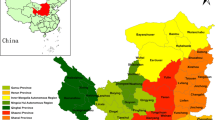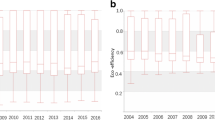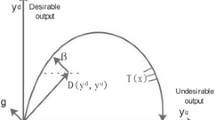Abstract
At present, the contradiction between economic development and resource and environmental sustainability has become increasingly acute in China. Improving the quality of the ecological environment has become an important strategic goal for China’s national economic and social development. In this paper, we used the panel data of 30 provinces in China from 1986 to 2016 to measure the eco-efficiency and its decomposition indexes based on a non-radial metafrontier Malmquist-Luenberger data envelopment analysis model. The results showed that the eco-efficiency grows at an annual rate of 0.7% on the whole, with the technical efficiency decreasing at an annual rate of 0.6%, the innovation effect increasing at an annual rate of 2.3%, and the technical leadership effect decreasing at an annual rate of 1%. In the sample study period, the cumulative growth rates of eco-efficiency change index, technical efficiency change index, innovation effect, and technical leadership effect were 20.4%, − 19.4%, 70.5%, and − 30.7%, respectively. It was also found that regional eco-efficiency decreased from east to west. Furthermore, convergence test results showed that there were four convergence clubs and three divergent individuals in terms of eco-efficiency. Areas with high eco-efficiency tended to converge with areas with high eco-efficiency and vice versa.



Similar content being viewed by others
Notes
For eases of expression, the distance function \( \overrightarrow{\mathrm{D}}\left(v,\boldsymbol{p};-\boldsymbol{p}\right) \) was expressed as \( \overrightarrow{\mathrm{D}}\left(v,\boldsymbol{p}\right) \).
Eastern provinces are Beijing, Tianjin, Hebei, Liaoning, Shanghai, Jiangsu, Zhejiang, Fujian, Shandong, Guangdong, and Hainan; central provinces are Shanxi, Inner Mongolia, Jilin, Heilongjiang, Anhui, Jiangxi, Henan, Hubei, Guangxi, and Hunan; western provinces are Chongqing, Sichuan, Guizhou, Yunnan, Shaanxi, Gansu, Qinghai, Ningxia, and Xinjiang.
Through the Monte Carlo simulation experiment, PS (2007) recommended that r = 0.3 be an appropriate choice when T < 50.
It is to note that all the eco-efficiency is less than one, and its absolute value will grow larger with low eco-efficiency after taking the logarithm, so that we have seen hit decreasing with higher eco-efficiency in clubs (or individuals) and increasing with lower eco-efficiency in clubs (or individuals).
References
Arabi, B., Munisamy, S., & Emrouznejad, A. (2015). A new slacks-based measure of Malmquist–Luenberger index in the presence of undesirable outputs. Omega, 51, 29–37. https://doi.org/10.1016/j.omega.2014.08.006.
Arabi, B., Munisamy, S., Emrouznejad, A., Toloo, M., & Ghazizadeh, M. S. (2016). Eco-efficiency considering the issue of heterogeneity among power plants. Energy, 111, 722–735. https://doi.org/10.1016/j.energy.2016.05.004.
Barba-Gutiérrez, Y., Adenso-Díaz, B., & Lozano, S. (2009). Eco-efficiency of electric and electronic appliances: a data envelopment analysis (DEA). Environmental Modeling and Assessment, 14(4), 439–447. https://doi.org/10.1007/s10666-007-9134-2.
Boussemart, J. P., Briec, W., Kerstens, K., & Poutineau, J. C. (2003). Luenberger and Malmquist productivity indices: theoretical comparisons and empirical illustration. Bulletin of Economic Research, 55(4), 391–405.
Camarero, M., Castillo-Giménez, J., Picazo-Tadeo, A. J., & Tamarit, C. (2013). Is eco-efficiency in greenhouse gas emissions converging among European Union countries? Empirical Economics, 47(1), 143–168. https://doi.org/10.1007/s00181-013-0734-1.
Chang, M.-C., & Hu, J.-L. (2018). A long-term meta-frontier analysis of energy and emission efficiencies between G7 and BRICS. Energy Efficiency, 12(4), 879–893. https://doi.org/10.1007/s12053-018-9696-7.
Chang, T.-P., Hu, J.-L., Chou, R. Y., & Sun, L. (2012). The sources of bank productivity growth in China during 2002–2009: a disaggregation view. Journal of Banking & Finance, 36(7), 1997–2006. https://doi.org/10.1016/j.jbankfin.2012.03.003.
Dirik, C., Şahin, S., & Engin, P. (2018). Environmental efficiency evaluation of Turkish cement industry: an application of data envelopment analysis. Energy Efficiency, 12(8), 2079–2098. https://doi.org/10.1007/s12053-018-9764-z.
Ebert, U., & Welsch, H. (2004). Meaningful environmental indices: a social choice approach. Journal of Environmental Economics and Management, 47(2), 270–283. https://doi.org/10.1016/j.jeem.2003.09.001.
Fan, Y., Bai, B., Qiao, Q., Kang, P., Zhang, Y., & Guo, J. (2017). Study on eco-efficiency of industrial parks in China based on data envelopment analysis. Journal of Environmental Management, 192, 107–115. https://doi.org/10.1016/j.jenvman.2017.01.048.
Godoy-Duran, A., Galdeano-Gomez, E., Perez-Mesa, J. C., & Piedra-Munoz, L. (2017). Assessing eco-efficiency and the determinants of horticultural family-farming in southeast Spain. Journal of Environmental Management, 204(Pt 1), 594–604. https://doi.org/10.1016/j.jenvman.2017.09.037.
Gomez, T., Gemar, G., Molinos-Senante, M., Sala-Garrido, R., & Caballero, R. (2018). Measuring the eco-efficiency of wastewater treatment plants under data uncertainty. Journal of Environmental Management, 226, 484–492. https://doi.org/10.1016/j.jenvman.2018.08.067.
Gudipudi, R., Lüdeke, M. K. B., Rybski, D., & Kropp, J. P. (2018). Benchmarking urban eco-efficiency and urbanites’ perception. Cities, 74, 109–118. https://doi.org/10.1016/j.cities.2017.11.009.
He, S. (2011). Research on the impact of foreign direct investment on the unbalanced growth of China’s regional economy. Productivity Research, 4, 102–104 (in Chinese).
Hou, M., & Yao, S. (2019). Convergence and differentiation characteristics on agro-ecological efficiency in China from a spatial perspective. China Population, Resources and Environment, 29(4), 116–126 in Chinese.
Hu, W., Guo, Y., Tian, J., & Chen, L. (2019). Eco-efficiency of centralized wastewater treatment plants in industrial parks: a slack-based data envelopment analysis. Resources, Conservation and Recycling, 141, 176–186. https://doi.org/10.1016/j.resconrec.2018.10.020.
Huang, J., Yang, X., Cheng, G., & Wang, S. (2014). A comprehensive eco-efficiency model and dynamics of regional eco-efficiency in China. Journal of Cleaner Production, 67, 228–238. https://doi.org/10.1016/j.jclepro.2013.12.003.
Kiani Mavi, R., Saen, R. F., & Goh, M. (2019). Joint analysis of eco-efficiency and eco-innovation with common weights in two-stage network DEA: a big data approach. Technological Forecasting and Social Change, 144, 553–562. https://doi.org/10.1016/j.techfore.2018.01.035.
Kortelainen, M. (2008). Dynamic environmental performance analysis: a Malmquist index approach. Ecological Economics, 64(4), 701–715. https://doi.org/10.1016/j.ecolecon.2007.08.001.
Krüger, J. J. (2003). The global trends of total factor productivity: evidence from the nonparametric Malmquist index approach. Oxford Economic Papers, 55(2), 265–286.
Kuosmanen, T., & Kortelainen, M. (2005). Measuring eco-efficiency of production with data envelopment analysis. Journal of Industrial Ecology, 9(4), 59–72.
Li, X., & Lu, X. (2010). International trade, pollution industry transfer and Chinese industrial CO2 emissions. Economic Research Journal, 1, 15–26 in Chinese.
Li, K., & Song, M. (2016). Green development performance in China: a Metafrontier non-radial approach. Sustainability, 8(3), 219. https://doi.org/10.3390/su8030219.
Lin, B., & Huang, G. (2011). The evolution trend of regional carbon emissions in china under the gradient development model——based on the perspective of spatial analysis. Journal of Financial Research, 378(12), 35–46 in Chinese.
Liu, J., Zhang, J., & Fu, Z. (2017). Tourism eco-efficiency of Chinese coastal cities–analysis based on the DEA-Tobit model. Ocean and Coastal Management, 148, 164–170. https://doi.org/10.1016/j.ocecoaman.2017.08.003.
Long, X., Sun, M., Cheng, F., & Zhang, J. (2017). Convergence analysis of eco-efficiency of China’s cement manufacturers through unit root test of panel data. Energy, 134, 709–717. https://doi.org/10.1016/j.energy.2017.05.079.
Ma, X., Li, Y., Changxin, W., & Yu, Y. (2018). Ecological efficiency in the development of circular economy of China under hard constraints based on an optimal super efficiency SBM-Malmquist-Tobit model. China Environmental Science, 38(9), 3584–3593 in Chinese.
Monastyrenko, E. (2017). Eco-efficiency outcomes of mergers and acquisitions in the European electricity industry. Energy Policy, 107, 258–277. https://doi.org/10.1016/j.enpol.2017.04.030.
Moutinho, V., Fuinhas, J. A., Marques, A. C., & Santiago, R. (2018). Assessing eco-efficiency through the DEA analysis and decoupling index in the Latin America countries. Journal of Cleaner Production, 205, 512–524. https://doi.org/10.1016/j.jclepro.2018.08.322.
Oh, D.-h. (2010a). A global Malmquist-Luenberger productivity index. Journal of Productivity Analysis, 34(3), 183–197.
Oh, D.-h. (2010b). A metafrontier approach for measuring an environmentally sensitive productivity growth index. Energy Economics, 32(1), 146–157. https://doi.org/10.1016/j.eneco.2009.07.006.
Olsthoorn, X., Tyteca, D., Wehrmeyer, W., & Wagner, M. (2001). Environmental indicators for business: a review of the literature and standardization methods. Journal of Cleaner Production, 9, 453–463.
Pan, X., Pan, X., Jiao, Z., Song, J., & Ming, Y. (2019). Stage characteristics and driving forces of China’s energy efficiency convergence—an empirical analysis. Energy Efficiency, 12(8), 2147–2159. https://doi.org/10.1007/s12053-019-09825-8.
Panopoulou, E., & Pantelidis, T. (2009). Club convergence in carbon dioxide emissions. Environmental and Resource Economics, 44(1), 47–70. https://doi.org/10.1007/s10640-008-9260-6.
Phillips, P. C., & Sul, D. (2007). Transition modeling and econometric convergence tests. Econometrica, 75(6), 1771–1855.
Phillips, P. C. B., & Sul, D. (2009). Economic transition and growth. Journal of Applied Econometrics, 24(7), 1153–1185. https://doi.org/10.1002/jae.1080.
Picazo-Tadeo, A. J., Beltrán-Esteve, M., & Gómez-Limón, J. A. (2012). Assessing eco-efficiency with directional distance functions. European Journal of Operational Research, 220(3), 798–809. https://doi.org/10.1016/j.ejor.2012.02.025.
Picazo-Tadeo, A. J., Castillo-Giménez, J., & Beltrán-Esteve, M. (2014). An intertemporal approach to measuring environmental performance with directional distance functions: greenhouse gas emissions in the European Union. Ecological Economics, 100, 173–182. https://doi.org/10.1016/j.ecolecon.2014.02.004.
Shao, L., Yu, X., & Feng, C. (2019). Evaluating the eco-efficiency of China’s industrial sectors: a two-stage network data envelopment analysis. Journal of Environmental Management, 247, 551–560. https://doi.org/10.1016/j.jenvman.2019.06.099.
Tang, L., & Hu, Z. (2016). Production factors, FDI, environmental depletion and sources of economic growth in China-decomposition from the biennial Malmquist productivity index. Xitong Gongcheng Lilun yu Shijian/System Engineering Theory and Practice, 36(3), 581–592. https://doi.org/10.12011/1000-6788(2016)03-0581-12.
Tang, L., & Li, K. (2019). A comparative analysis on energy-saving and emissions-reduction performance of three urban agglomerations in China. Journal of Cleaner Production, 220, 953–964. https://doi.org/10.1016/j.jclepro.2019.02.202.
Wang, H., & Yang, J. (2019). Total-factor industrial eco-efficiency and its influencing factors in China: a spatial panel data approach. Journal of Cleaner Production, 227, 263–271. https://doi.org/10.1016/j.jclepro.2019.04.119.
Wang, B., & Zhang, W. (2018). Cross-provincial differences in determinants of agricultural eco-efficiency in China: an analysis based on panel data from 31 provinces in 1996-2015. Chinese Rural Economy, 1, 46–62 in Chinese.
Wang, L., Xi, F., Yin, Y., Wang, J., & Bing, L. (2019a). Industrial total factor CO2 emission performance assessment of Chinese heavy industrial province. Energy Efficiency, 13, 177–192. https://doi.org/10.1007/s12053-019-09837-4.
Wang, X., Ding, H., & Liu, L. (2019b). Eco-efficiency measurement of industrial sectors in China: a hybrid super-efficiency DEA analysis. Journal of Cleaner Production, 229, 53–64. https://doi.org/10.1016/j.jclepro.2019.05.014.
Xing, L., Xue, M., & Wang, X. (2018). Spatial correction of ecosystem service value and the evaluation of eco-efficiency: a case for China’s provincial level. Ecological Indicators, 95, 841–850. https://doi.org/10.1016/j.ecolind.2018.08.033.
Yang, Y., & Deng, X. (2019). The spatio-temporal evolutionary characteristics and regional differences in affecting factors analysis of China’s urban eco-efficiency. Scientia Geographica Sinica, 39(7), 1111–1118 in Chinese.
Zhao, Z., Bai, Y., Wang, G., Chen, J., Yu, J., & Liu, W. (2018). Land eco-efficiency for new-type urbanization in the Beijing-Tianjin-Hebei region. Technological Forecasting and Social Change, 137, 19–26. https://doi.org/10.1016/j.techfore.2018.09.031.
Zhou, P., Ang, B. W., & Poh, K. L. (2006). Comparing aggregating methods for constructing the composite environmental index: an objective measure. Ecological Economics, 59(3), 305–311. https://doi.org/10.1016/j.ecolecon.2005.10.018.
Zhou, P., Ang, B. W., & Wang, H. (2012). Energy and CO2 emission performance in electricity generation: a non-radial directional distance function approach. European Journal of Operational Research, 221(3), 625–635. https://doi.org/10.1016/j.ejor.2012.04.022.
Zhou, M., Wang, T., Yan, L., & Xie, X. (2019a). Heterogeneity in the influence of fiscal decentralization and economic competition on China’s energy ecological efficiency. Resources Science, 41(3), 532–545 in Chinese.
Zhou, Y., Kong, Y., Sha, J., & Wang, H. (2019b). The role of industrial structure upgrades in eco-efficiency evolution: spatial correlation and spillover effects. Science of the Total Environment, 687, 1327–1336. https://doi.org/10.1016/j.scitotenv.2019.06.182.
Funding
We acknowledge the financial support from the Social Science Foundation of Hunan Province (No. 16YBA284), Social Science Foundation of Zhuzhou (No. ZZSK19152), and National Natural Science Foundation of Hunan Province (No. 2018JJ3353, No. 2019JJ50131), Social Science Achievement Evaluation Committee Foundation of Hunan Province (No. XSP20YBC347), Humanity and Social Science Foundation of Ministry of Education of China (No. 20YJCZH145, No. 17YJCZH195), China Scholarship Conncil (No. 201906725035).
Author information
Authors and Affiliations
Corresponding author
Ethics declarations
Conflict of interest
The authors declare that they have no conflict of interest.
Additional information
Publisher’s note
Springer Nature remains neutral with regard to jurisdictional claims in published maps and institutional affiliations.
Rights and permissions
About this article
Cite this article
Tang, J., Tang, L., Li, Y. et al. Measuring eco-efficiency and its convergence: empirical analysis from China. Energy Efficiency 13, 1075–1087 (2020). https://doi.org/10.1007/s12053-020-09859-3
Received:
Accepted:
Published:
Issue Date:
DOI: https://doi.org/10.1007/s12053-020-09859-3




